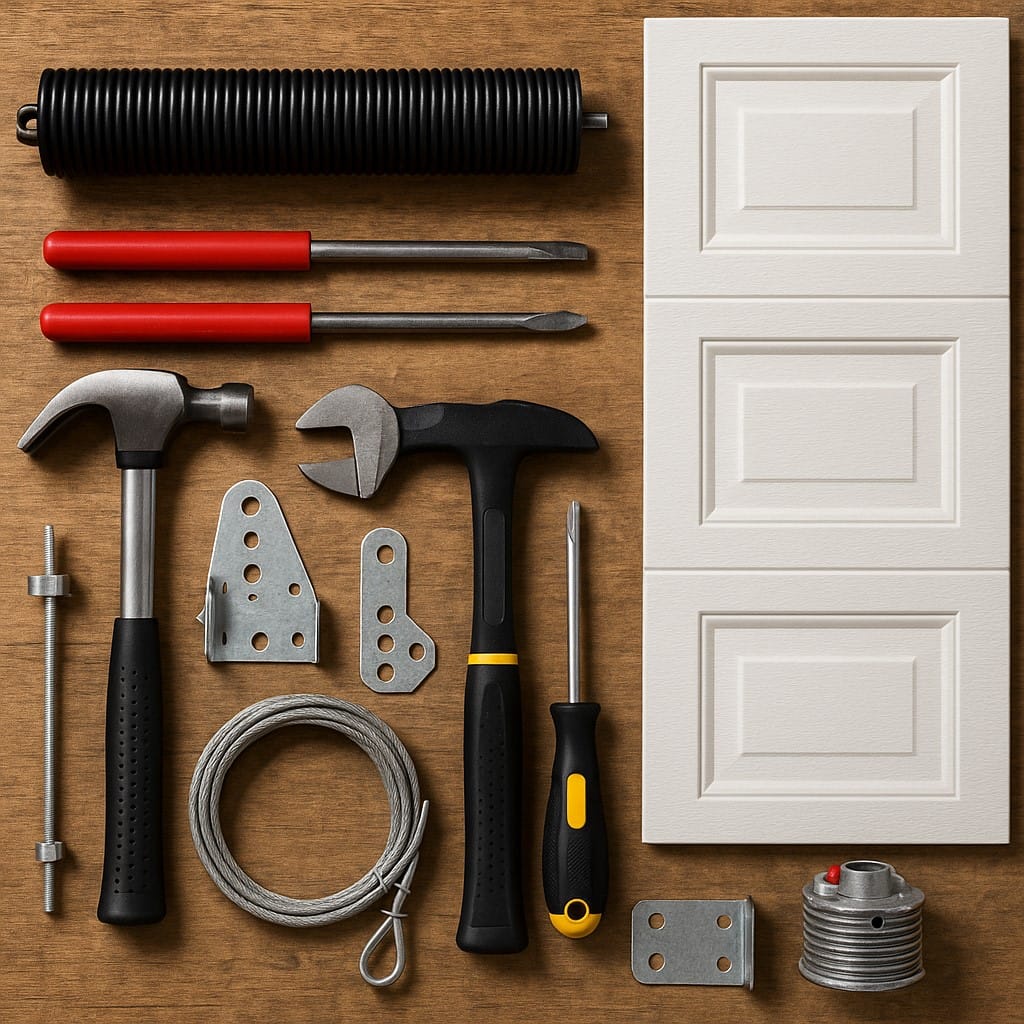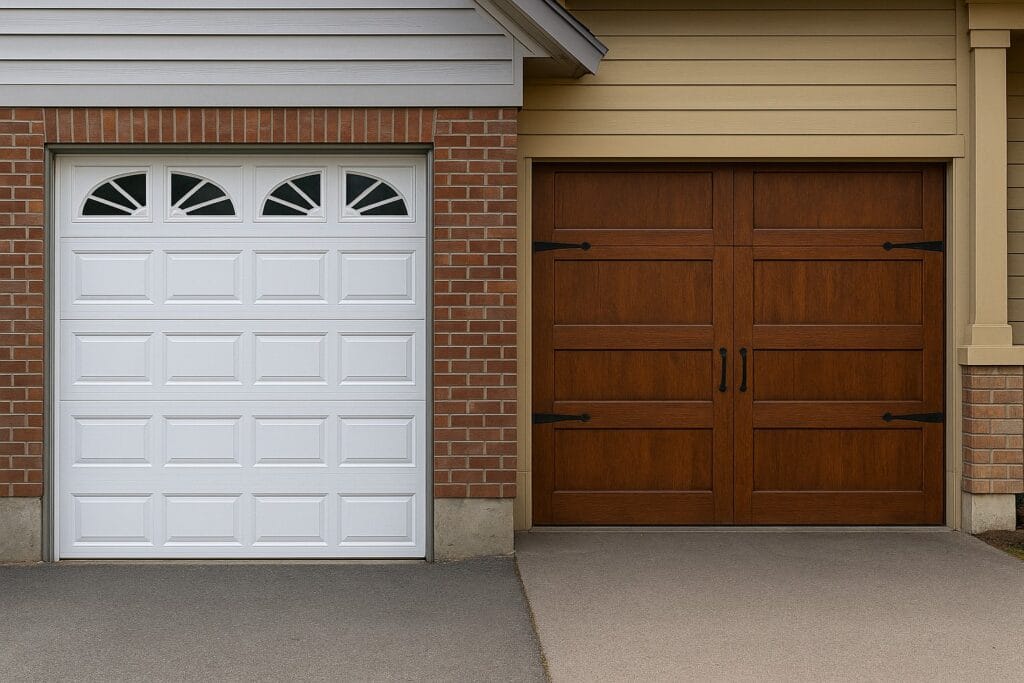Steel vs. Wood: Best Choices for Replacing Garage Door

Replacing garage door is more than just an upgrade; it’s an investment in your home’s value, curb appeal, energy efficiency, and safety. At Texoma Garage Door Center Co., we recently worked with a homeowner near Sherman, TX, who was experiencing major issues with their old wooden garage door. The bottom panel had rotted, the door springs were worn, and the garage door opener kept failing during power outages. After reviewing their options, we walked them through the pros and cons of steel and wood doors, helping them make a confident, informed decision.
According to the Door & Access Systems Manufacturers Association (DASMA), a new garage door offers one of the highest returns on investment for home improvement projects. It also plays a key role in maintaining insulation, especially in attached garages, where maintaining a consistent internal temperature helps reduce HVAC energy use. Choosing the right material affects every part of the system, from the garage door springs and opener to the tracks, panels, and overall appearance.
Whether you’re upgrading for looks, safety, or function, the choice between a steel and wood garage door matters. This comprehensive guide from Texoma Garage Door Center Co. in Sherman, TX, will walk you through everything you need to know about the replacement process, door materials, maintenance requirements, insulation value, and modern features like smart garage door openers and backup batteries.
Why Garage Door Material Matters: A Comprehensive Guide
When it comes to garage door replacement, homeowners often focus on appearance or cost alone. But the material impacts so much more: energy efficiency, durability, smart features, garage door opener compatibility, and even how often you’ll need service. The material of your new door also determines what kind of torsion springs or extension springs will be needed, what kind of insulation (like polyurethane foam or polystyrene) can be applied, and the tools required during installation.

Choosing the right material for your garage door ensures smoother operation, reduces the chances of costly repairs, and enhances long-term home value. Your garage door system includes moving parts like rollers, cables, hinges, brackets, and the opener, each part working together along the track. The wrong material could mean more frequent garage door repair visits, especially if the door panels don’t handle your region’s climate well.
Let’s explore two of the most common materials, steel and wood, and how they hold up in different conditions.
Steel Garage Doors: Built for Durability, Strength & Modern Features
Steel garage doors are among the most popular choices today for both residential and commercial properties. Their strength, longevity, and compatibility with modern technology make them a smart choice for many Sherman homeowners.
Advantages of Steel Garage Doors
- High Durability and Strength
Steel is built to last. It resists dents, cracking, and corrosion (especially when properly coated), and can endure extreme temperatures and weather changes. For garages exposed to heavy use or areas prone to high winds or hail, a steel door, particularly those with reinforced panel designs and sturdy torsion spring systems, offers strong protection. - Minimal Maintenance
Steel requires little upkeep compared to wood. Occasional washing with soap and water is often all that’s needed. Unlike wood, you won’t need to worry about sanding, painting, or sealing the surface to prevent rot or pest damage. - Energy Efficiency Options
Insulated steel garage doors often include layers of polyurethane or polystyrene insulation. These materials offer high R-values (insulation value), helping maintain a comfortable garage temperature and reduce energy costs. This is especially helpful if you use your garage as a workspace or have an attached garage influencing your home’s HVAC system. - Smart Garage Door Compatibility
Steel doors work well with modern garage door openers, including Chamberlain and LiftMaster garage door systems. These openers often support smart features like Wi-Fi connectivity, smartphone access, integration with Amazon Alexa or Google Assistant, and backup battery systems in case of a power outage. - Affordable Pricing
When you factor in installation cost, insulation features, and long-term service requirements, steel doors are often the most economical choice. They offer a great balance of upfront cost and long-term value.
Disadvantages of Steel Garage Doors
- Risk of Rust
If the paint or protective coating gets damaged, steel can rust, especially in humid or coastal environments. Regular maintenance of the exterior finish is essential to prevent corrosion and extend door life. - Less Customization
While modern steel garage doors come in various styles and colors, they generally lack the handcrafted charm and natural grain of real wood. You can, however, opt for woodgrain-textured panels or decorative hardware for a more traditional look.
Wood Garage Doors: Classic Beauty with a Need for Upkeep
Wood garage doors offer a timeless appearance that complements many architectural styles. They are particularly popular for homeowners seeking a traditional, rustic, or upscale look.
Advantages of Wood Garage Doors
- Aesthetic Excellence
The natural beauty of wood provides unmatched curb appeal. From stained cedar to painted redwood, wood garage doors add warmth and charm to any home. Homeowners can match their wood panels to other exterior features like shutters or fences for a cohesive appearance. - High Customization
Wood doors are often handcrafted, offering full control over panel layout, decorative hardware, windows, and even unique carvings. You can opt for different species, finishes, and paint colors to complement your home’s design. - Sturdy Build
Solid wood doors are naturally strong and, with the right hardware, provide excellent protection. Properly installed torsion springs and a strong opener ensure smooth operation despite the heavier weight.
Disadvantages of Wood Garage Doors
- High Maintenance Requirements
Wood doors need regular maintenance to prevent moisture damage, warping, cracking, and pest infestations. Expect to repaint or reseal every couple of years, especially in humid or rainy climates. - Higher Cost
Between the material, custom craftsmanship, and maintenance, wood doors come with a higher garage door cost both initially and over time. Replacement parts may also be more expensive or difficult to match. - Energy Inefficiency Without Insulation
Unless specially constructed with added foam insulation, solid wood garage doors may not provide the same energy efficiency as insulated steel doors.
Comparing Steel and Wood Garage Doors: A Side-by-Side Guide
Feature | Steel Garage Door | Wood Garage Door |
Durability | High–resists dents, cracking, and corrosion | Moderate – requires upkeep to prevent damage |
Maintenance | Low – wash occasionally | High – needs regular sealing, painting |
Insulation Value (R-Value) | Excellent with foam insulation | Moderate unless upgraded |
Aesthetics | Modern or industrial styling options | Classic, rustic, or upscale appearance |
Customization | Limited design options | Fully customizable materials and finishes |
Smart Features | Works with smart openers and backup battery | Compatible, but may require stronger motors |
Cost | Generally lower installation and repair costs | Higher upfront and long-term cost |

Tips for Replacing Garage Door in Sherman, TX
Before replacing a garage door, consider these tips to make the best choice:
- Evaluate Your Environment
Sherman and the nearby areas experience heat, humidity, and storms. Steel may be the better choice for weather resistance and easier upkeep. - Think About Long-Term Costs
While wood may offer stunning visuals, it’s more expensive to maintain. Steel doors may be more practical in the long run. - Don’t Forget Smart Features
Garage doors with built-in smart features, like smartphone control and power backup systems, add convenience and safety, especially during a power outage. - Match the Right Opener
Heavier wood doors require powerful garage door openers with reinforced brackets, torsion springs, and safety features to ensure smooth operation. - Call the Experts
Garage door replacement is not a DIY task. From aligning tracks to securing door springs and setting up smart openers, it takes professional tools and experience.
How Can Texoma Garage Door Center Co. Help You?
At Texoma Garage Door Center Co., we specialize in professional garage door services tailored to your unique needs. Whether you’re installing a new garage door, replacing your old door, or simply exploring your options, our experienced team provides step-by-step guidance to help you choose the right garage door for your home or business.
We offer full services including:
- Garage Door Installation
- Custom Panel and Material Selection
- Garage Door Repair & Part Replacement
- Smart Garage Door Opener Setup
- Backup Battery and Safety Feature Integration
- Torsion Spring and Track Adjustment
- Energy Efficiency and Insulation Upgrades
📍 Visit us at:
1733 Texoma Pkwy, Sherman, TX 75090
📞 Call us today: (430) 255-5451
Trust us to deliver fast, reliable service with a friendly touch. Let Texoma Garage Door Center Co. help you find the perfect garage door that meets your needs, matches your style, and works flawlessly for years to come.
Frequently Asked Questions (FAQs)
1. How long does it take to replace a garage door?
Most garage door replacements can be completed within 4 to 6 hours, but custom or heavier doors like wood may take longer due to extra adjustments and setup.
2. Can I replace my garage door without changing the opener?
Yes, but it depends on compatibility if your old opener isn’t strong enough for the new door’s weight or lacks modern safety features, a new opener is recommended.
3. Which garage door type adds more value to my home?
Steel doors typically offer a higher return on investment due to their durability, energy efficiency, and low maintenance, especially in real estate appraisals.
4. Is it possible to add windows to steel or wood garage doors?
Absolutely—both materials allow for window inserts, and you can choose various shapes, glass types, and placements for light, style, and privacy.
